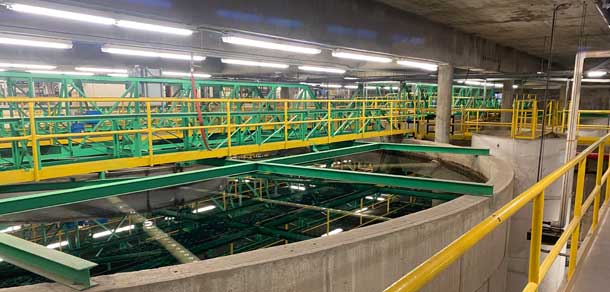Buffalo Pound Water Treatment assures safe, clean drinking water
Water is a crucial element for all living things.
The majority of Canadians have access to clean and safe drinking water, made possible by water treatment plants where raw water is made safe to drink through a series of specialized processes before made available to the public.
But what happens if that water supply is contaminated, say, by a potentially lethal virus like COVID-19?
The Buffalo Pound Water Treatment Plant, commissioned in 1955, is one of the largest, most important and most sensitive components of the province’s water infrastructure.
With a rated capacity of 205 million litres per day and supplying safe drinking water to approximately 260,000 customers in Regina and Moose Jaw, the plant is too big to fail.
“We’re not only critical, but we’re also an essential service. We cannot fail,” said Ryan Johnson, P.Eng., general manager at the Buffalo Pound Water Treatment Plant. “We cannot be in a position where we cannot supply water to one quarter of the provincial population.”
No COVID-19 in water
Buffalo Pound Water Treatment Plant has won awards for its water quality and ranks among the best in western Canada.
Recently, Canadians were alarmed when they learned that nearly 70 employees at a beef processing plant in southeast Alberta tested positive for the coronavirus. This immediately prompted concerns over the possibility of contaminated meat reaching the public. The outbreak also raised the question of whether Canada’s beef supply would be affected if the plant were to temporarily cease operation.
A similar scenario and subsequent questions were foremost on the minds of Johnson and his staff at the Buffalo Pound facility.
Can our drinking water become contaminated by the coronavirus either organically or through transmission from an infected employee at the water treatment plant?
“We’re designed to be able to address bacteria and viruses,” Johnson explained. “Based on our treatment processes using UV disinfection as well as free chlorine, we are able to eliminate COVID-19. We know we would never be contributing to the problem. Even if we had COVID-19 coming in on the raw water side, the treatment plant can ensure that on the output side it was not there.”
Therefore, Johnson considered the possibility of the water supply becoming infected to be a non-issue.
He said a lab at the plant conducts chemical and microbiological analysis which regularly monitors the quality of the raw and treated water. Because so few people in Saskatchewan contracted the coronavirus, the chances of staff at the plant seeing evidence of it in the water would be next to nothing.
Johnson added that it may be possible to detect the virus in the wastewater in New York City, where more than 162,000 people have contracted the virus. That’s more than three times Canada’s total.
When water is treated at the Buffalo Pound plant, it goes through multiple processes. First, any large debris is removed from the raw water. From there, chemicals are added to change the electrical charge and density and eventually eliminate approximately 95 per cent of the impurities in the water. The remaining five per cent is run through filters that will remove an additional 4.99 per cent. Addition of chlorine and UV disinfection ensures the water is safe to drink.
Award-winning water
Buffalo Pound Water Treatment Plant
In fact, the work being done at Buffalo Pound has been recognized as among the best in western Canada.
Because the raw water comes to the plant from Buffalo Pound Lake, a shallow and relatively warm body of water, there are taste and odour issues in the summer months. To combat this, the plant in 1985 was one of the pioneers in the use of the granular-activated carbon filtration process for the removal of algae-produced taste and odour.
The plant won the Best of the West Water Taste Test in 2014 and 2017 of western Canadian cities for water quality.
Winning these awards is the end result of management and staff at the plant dedicated to the jobs they do so they can take pride in the end result – safe drinking water for the public.
Ahead of the curve
The possibility of our water supply becoming contaminated with COVID-19 is a non-issue, according to Ryan Johnson, P.Eng., general manager at Buffalo Pound Water Treatment Plant.
Whether it was suspicion or anticipation, Johnson and staff at the plant in early February felt the coronavirus something much more serious than what was being let on. As such, the timing was ideal to update the plant’s business continuity plan.
The plan had been in place for several years and was designed to be applied to a SARS or H1N1 outbreak.
“If we had a work stoppage or a strike or an H1N1 outbreak or something that prevented staff from coming to work, we have to ask ourselves how do we do the job with fewer people,” Johnson said. “All of our plans are similar. We would just have to apply it to what is happening at the time.”
No staff at the plant has fallen ill over the past few weeks and Johnson has reason to believe it may be because of the preventative measures and lines of defence that were instituted in March. The business continuity plan was updated in February and fully executed in mid-March.
Under normal circumstances, the plant operates around the clock, seven days a week. In total, there are 36 staff that work at the plant. During a regular work week, there are two operators and as many as 24 others on site. Two operators keep the plant running off hours.
These days, however, operational procedures have been altered.
Of the nine operators on staff, two are working at the plant during every shift. Operators are found at two different locations in the plant and are protected (or isolated) from other staff because they work independently in a sealed control room. In order to talk to operators on shift, staff must phone into the control room.
Maintenance and laboratory staff work Monday to Friday. Normally, there are 24 in the plant for each shift. Now, this number has been halved. Johnson said while 12 staff are working at the plant, the remaining 12 are expected to be at home self-isolating and available to come in on short notice.
Taking care of staff
Prior to minimizing staff on site, Johnson and his team tried to mitigate any anxiety felt by staff members by communicating, educating and using as much information as possible to supplement what staff were receiving from other sources. Staff was given a handbook specific to COVID-19 that addressed questions related to new measures being instituted.
In an effort to reduce the chances of staff getting sick, physical distancing measures were introduced. Staff is working independently and doing preventative maintenance duties by minimizing contact with others.
Johnson noted he has a reserve pool of staff members that work from home and retirees on standby.
As well, there is limited access to the plant. Only staff are allowed inside. Johnson said he and his management team are taking a wait-and-see approach before they determine when it is safe for a full complement of staff.
“From the public’s perspective, there is almost no change here,” he said. “We’re still providing potable water in the quantities and quality that is expected by the two cities that own us.”
“But we’ll definitely have to do a ‘lessons-learned’ from this process after we return to normal.”



